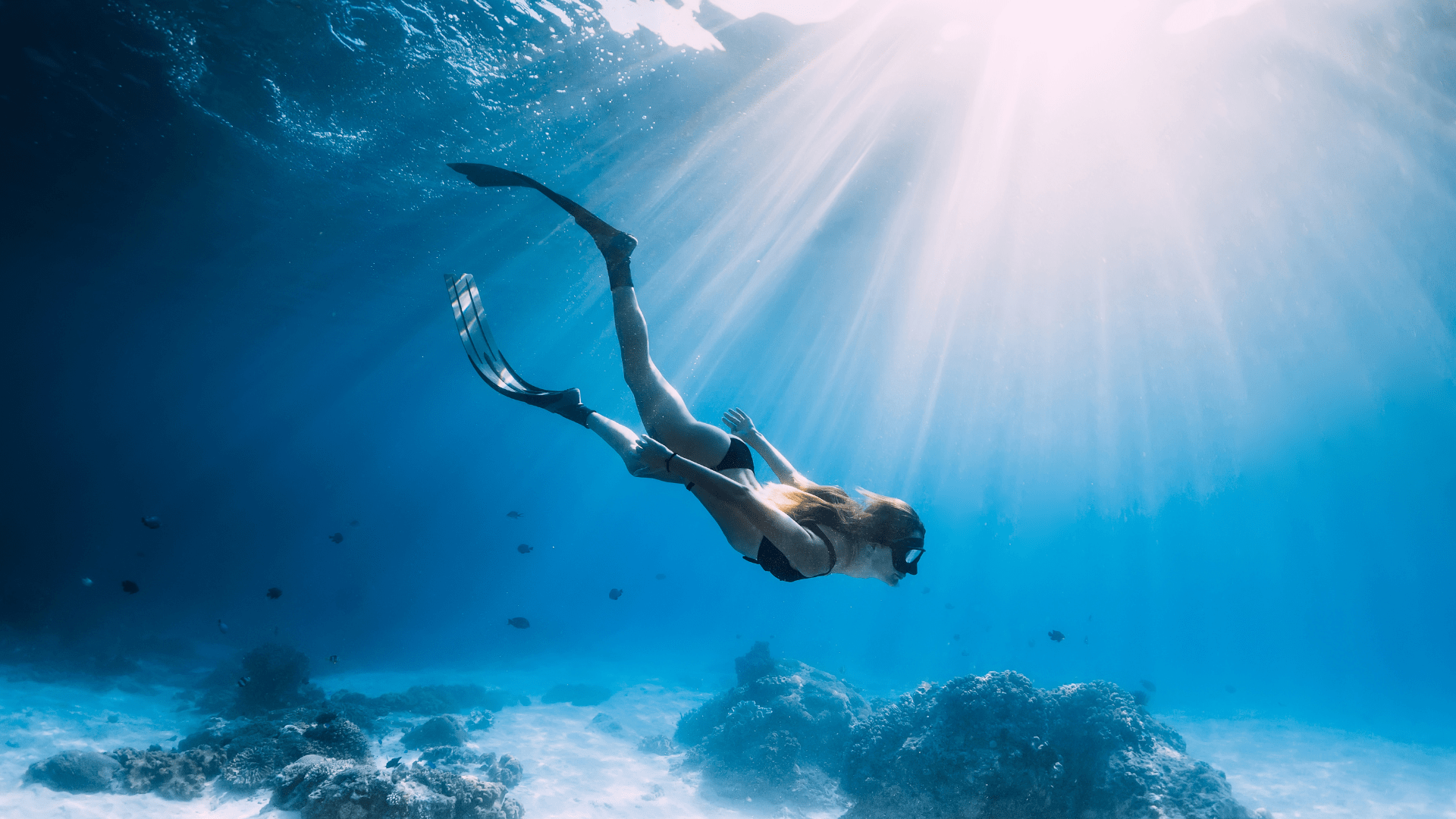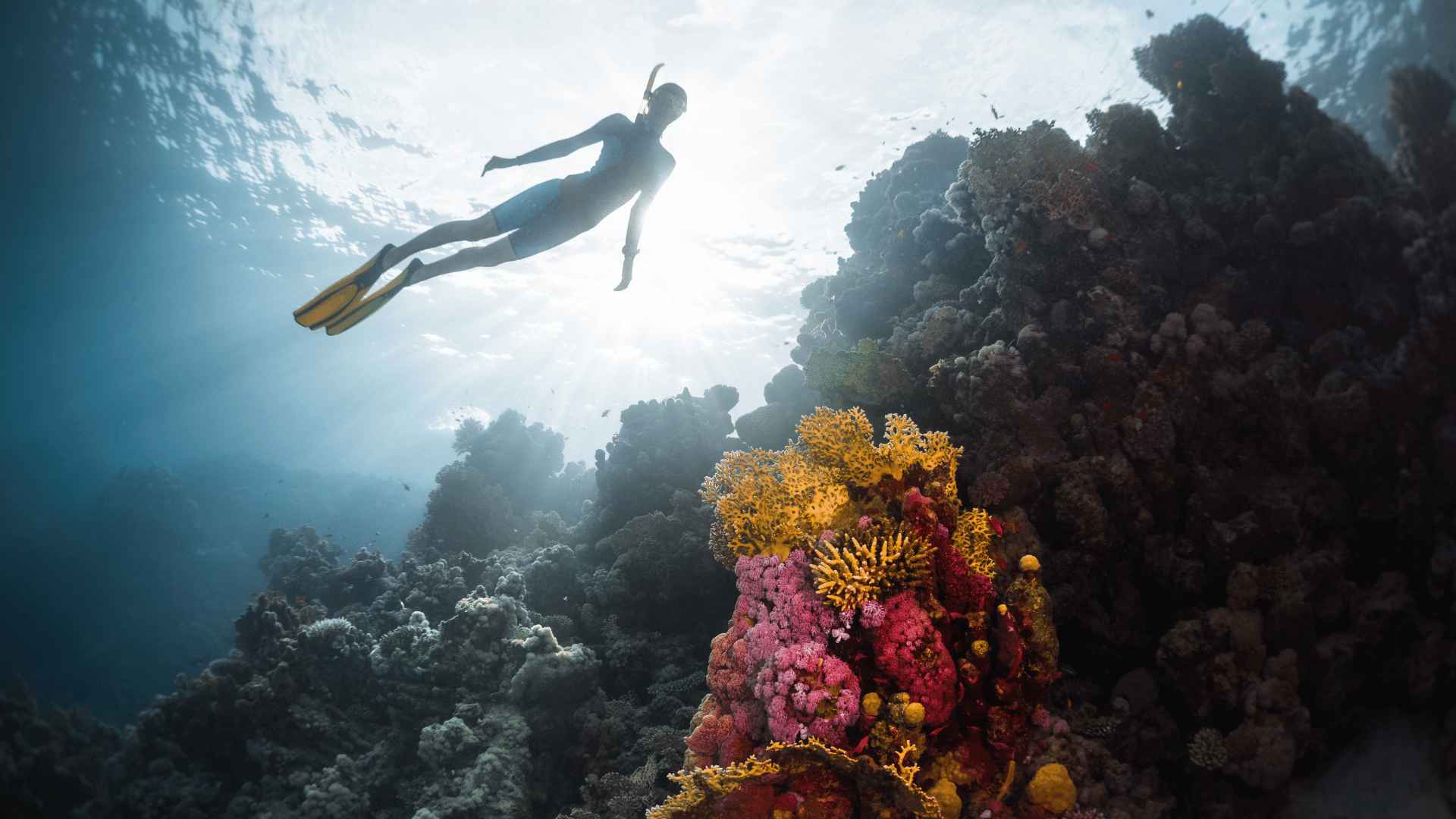Water provides us with an entirely immersive experience by simultaneously affecting all five senses. Think about yourself swimming in a calm bay. As you move, the water rippling and trickling against your skin feels cool. You can taste it as you breathe in the sea air—a tangy, salty flavor. Perhaps you smell seaweed or just loves to snorkel. You can see the sunlight dancing across the water's surface as the scene is bathed in hues of green and blue is already a form of relaxation. There isn't a more serene location that comes to mind other than the underwater world.
Perhaps you just took a quick dip after work, you feel safe, and all of your worries from the day have vanished. Why is it that being in the water feels so good?
One of the first types of diving and one that has been practiced for centuries is freediving. The basic idea of freediving is to hold your breath underwater and go as far as you can without coming to the surface to get oxygen. Freediving was first practiced by humans many years ago when they had to descend for food or to recover objects that had been lost overboard. Freediving has, nevertheless, developed into a fun hobby and competitive sport in more recent years.
What does freediving entail? You've had a taste of freediving if you've ever submerged yourself while swimming and holding your breath.
Continue reading whether your goal is to push your body to new limits and become a competitive freediver or if you just want to challenge yourself. Planning to take a freediving course? We will be examining the definition, structure, and varieties of freediving in this article.
What is freediving?
Swimming or diving underwater on a single breath is known as freediving. You have complete freedom to move underwater in a way that is entirely natural when you freedive. This is so because freedivers don't use scuba tanks or other large, challenging breathing apparatus. Freediving enables you to get much closer to marine life, swim, and interact in a way you never could have imagined with creatures like fish, dolphins, manta rays, and whale sharks without upsetting them. On the other hand, scuba diving is a water sport that involves breathing air from a tank while underwater.
Attempting to hold your breath underwater for as long as possible is a good place to start if you want to learn how to freedive. You can use this number as a starting point. Freediving basically starts with breath hold diving. Developing the practice of taking slow, deep breaths is the key to being able to hold one breath for longer underwater.
What gear do you need? A wetsuit designed specifically for freediving should fit you well, have the right thickness for the depth and water temperature you're diving in, and deliver the performance you want.
You might initially think that freediving and snorkeling are equivalent. But in reality, there are a few rather noticeable distinctions between the two. When snorkeling, divers must hold their breath while diving until they resurface and stay above the water's surface to breathe. In contrast, freedivers take off their breathing equipment before diving and just hold their breath for extended periods of time.
"What if I can't hold my breath for a long time?" is one of the most common questions for most people.This is a frequently asked question because a lot of people think it means they aren't cut out to be freedivers. But that's not the case at all. Through appropriate training, you will acquire breathing techniques that will enable the human body to hold breath for increasing periods of time, ultimately leading to the ability to freedive for an unexpectedly extended duration.
Types of freediving
Freediving offers various discipline and techniques for you to try,
1.Constant Weight
The most popular discipline in both recreational and competitive freediving is Constant Weight. Divers are not permitted to touch the line or release their weight during the ascent; they must use bi or mono fins for both descent and ascent. To descend to astonishing depths, they rely on their ability to breathe and cunning maneuvers. The activity puts your ability to move quickly through the water and your physical stamina to the test.
2.Free Immersion
In free immersion, divers pull themselves up and down without the use of fins by pulling themselves up and down a vertical rope. During the entire dive, the diver's body stays in contact with the rope. During the dive, free immersion preserves energy and permits effective movement. It calls for effective pulling methods. This discipline is the most controlled and facilitates easier equalization, so new divers can benefit from it.
3.Variable Weight
Divers using Variable Weight are able to descend to extremely deep levels using a weighted sled that is fastened to a vertical rope or cable. They can then swim or pull themselves to the surface. Using equipment reduces the effort needed to descend while enabling deeper dives. This discipline assesses the diver's quick equalization, buoyancy adaptability, and efficiency with additional equipment. Because divers can descend faster than they can ascend, this can be riskier. This is mostly applicable to advanced freedivers.
4.Dynamic Apnea
Using either a monofin (DYN) or bi-fin (DYNB), the horizontal distance traveled underwater in a single breath is measured in dynamic apnea. Additionally, fins are not used in this (DNF). The diver's ability to breathe while in motion, stroke efficiency, and technique are all put to the test by dynamic apnea.
Open water sessions are fun. In the Philippines, you can swim everywhere and take freediving courses. If you're in condo living in Metro Manila, you have nothing to worry about as you have an easy access to some freediving classes. You can enroll in a freediving course at FreedivePH: Freediving Philippines in San Juan, or at Apnea Philippines in Batangas.
Reasons to take a freediving course
Frequent freediving can improve your fitness level. Swimming is a fantastic full-body exercise program. In addition, as you work to get better at the sport, freediving can promote a healthy lifestyle and increase rib flexibility. Stretching first thing in the morning helps many freedivers stay flexible both dry and in the water. Some of these stretches are covered in your advanced certifications for freediving.
Nothing feels better than getting better at something, and there's always something new to learn about freediving. Even the best freedivers in the world admit that they are still beginners, constantly growing and learning.
Freediving may be an excellent way for you as an adventurer to express your spirit of exploration. The world's most breathtaking locations are home to the best shipwrecks, reefs, whales, and fish. A excellent reason to reserve flights is freediving, which allows you to experience new foods, waters, and cultures.
As a traveling freediver, you will encounter like-minded people and witness some of the world's best underwater life. Traveling really does broaden the mind.
Or perhaps you just have a passion for ocean exploration? A great way to discover the underwater world is through freediving. Given that it requires less equipment than scuba diving, it may be more convenient. With just a mask and fins, you can enter the water without worrying about bulky tanks or exceeding decompression limits.
There's enough underwater exploration to last a lifetime: caves, canyons, coral reefs, and shipwrecks. Gaining the skills necessary to freedive will enable you to spend more time underwater and take in the breathtaking marine life and its vivid colors.



